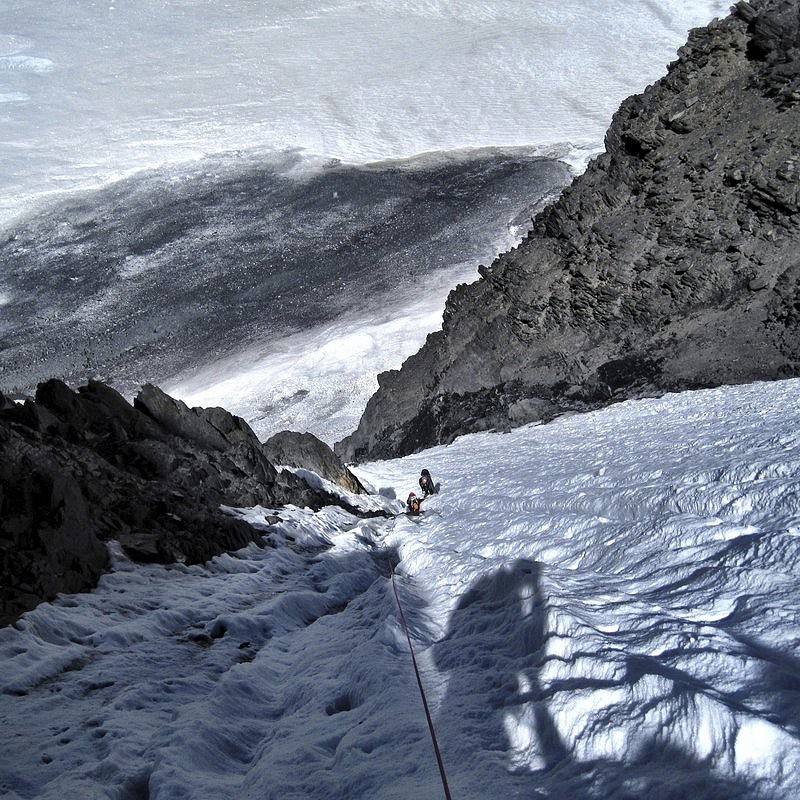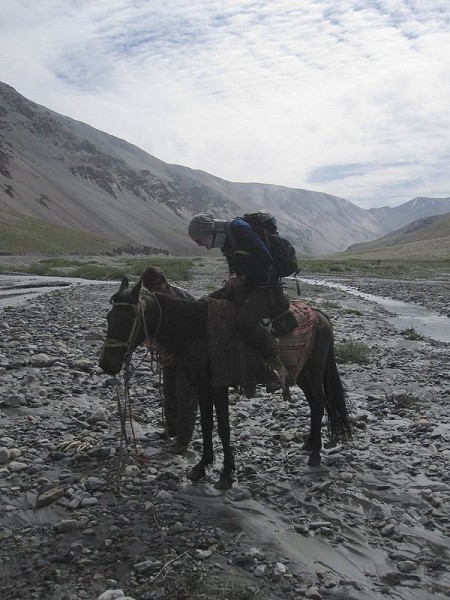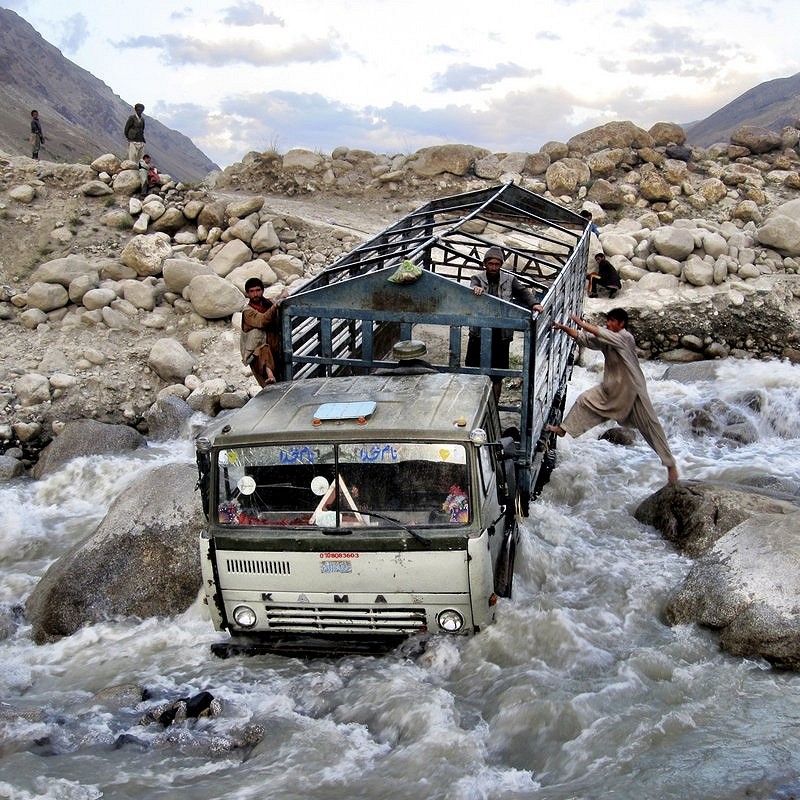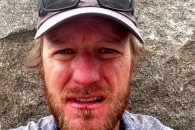
To be hit on the head by a single, large rock in a small rock fall at 5,400 metres on a large mountain could be considered unfortunate. Being at least 10 days from a hospital with a major head injury and no prospect of helicopter evacuation could be considered really unfortunate. To survive and then manage to walk out could be considered extremely fortunate indeed. This is the story of the 2013 Expedition to Koh e Qara Jilga, Afghanistan...
Alan Halewood and Richmond MacIntyre had met 2 years prior whilst crossing Liverpool Land by ski. Alan leading the trip; Richmond a paying client and serial adventurer. During this time an agreement was made to travel to North Eastern Afghanistan and attempt an ascent of the last unclimbed 6,000 metre peak that lies wholly within that nation. This having been spotted by Al on an earlier expedition to the area.
On such a trip, they decided, a team of three would be optimal in terms of cost, equipment and loads. Fortunate, as this allowed me an invitation to join.
We departed our respective home countries on the 11th of July, (I say we but in fact I left four days later due to a visa hold up). In Dushanbe, Tajikistan we met up and drove two days with a quiet but affable driver to Tajik Ishkishim, close to the Afghan border. Beyond lay the province of Badakshan and gateway to the Wakhan corridor, which we would follow by two days of rattling and banging driving to Sarhad. This we did, worsened by fierce stomach bugs, (never have I passed clear water out of there before)!
A tip for travelers planning to walk east into the Wakhan from Sarhad is to expressly request a guest house at, or very close to the end of the motorable road. Otherwise they could find themselves, as we did, in accommodation requiring some 5 kilometres additional walking. Not much it would seem but on our return, tired and thin, we resented it.
The first day from the road head isn't a gentle acclimatisation, unfortunately, as there is a pass at over 4,100 metres that must be crossed. Afterwards though our entry undulated along, mostly in the three thousands, following the Oxus River gorge all the way to Kasch Goz. Here were the Kirghiz people whom we would have to deal with for pack horses from here on in. The jovial Wakhi horsemen we said goodbye to. We negotiated fees for continuing our journey into Qara Jilga, (the Dark Valley), with the more reserved Kirghers and made the trek over two short days to the moraine at the foot of the Jilga glacier, at which point the horses could go no further.
4,200 metres.
The mountain is large and complex, consisting of four tops and a number of long ridges buttressing them. Of these the longer west ridge stood out as an obvious feature leading all the way, over several kilometres, from a rubbly start to a snowy arete arriving directly at the 6049 metre summit.
Our mapped information was large scale and very basic. We knew nothing of the East side of the mountain and as far as we were aware nobody had ever even been there. It would be necessary to make a reconnaissance, because if the West Ridge went, we would be still be looking at descending the hopefully simpler terrain on the East.
Base Camp, we decided, would be in a cirque near our prospective ridge at a height of 4,800 metres. From 4,200 there ensued a fairly purgatorial struggle up to base, load carrying over two days. The moraine here is probably the most awkward I have ever experienced; mounds of spoil, up and down, staggering against looseness and cursing the false horizon.

We set off the next morning. The plan was to climb the couloir to the crest and then descend back to base and benefit from some acclimitisation. Climb high; sleep low. At the top we would make an assessment of the ridge, (there were some higher sections visible from base, but tricky to make out, that could go either way). If it appeared feasible we could deposit a stash of bivvy gear, food and gas for a subsequent attempt.
The climbing was simple 45 degree, summery alpine snow, past the yawning bergshrund for a few hundred metres, moving together until a slight steepening and some very robust ice obliged us to start pitching. Characteristically the snow was pocked with fallen stones so we pressed on before it got too warm. So far, so good. Our progress was rapid despite the gasping and before long we arrived at the rightward bend in the couloir that had been obscured to me from below during my recce. Unfortunately there was no more snow, only a steep slabby wall with a distinctly fractious vibe about it. No go. A thin goulotte went left and offered a way, albeit a bit loose. I remember a few years ago, in the Dolomites, reading a guidebook translation of a route description. It went along the lines of "a cannelloni of detritus." Well, this was the same. Nonetheless we managed to balance up it without dislodging too much rubble onto each other. More of the same eventually let us reach the crest. Amazing views but what captured my attention by far was the awfulness of the ridge upwards. Huge piles of giant rotting slate, in mutual support, just waiting for the slightest disturbance to rumble off the mountain. I had thought that with all the signs of good weather for a few days and feeling well that we might just go for the summit, bivvying when we ran out of light. On viewing that lot, however, we unanimously decided to return to base and make a snowy ascent from the East in a few days time.
The ridge line downwards was also revolting, this meant that we would have to abseil the couloir after the sun went off. We felt vulnerable coming up and by doing this we would double our exposure, but it still looked a better option.

We eased down the first couple of abs, super careful. Much loose stuff everywhere but nothing extraordinary. Clear of this and on to the snow ice we moved fast; sliding down the ropes, searching for buried ice to make threads, build anchors, transfer off, wait for the others and repeat. Towers and walls loomed above, loosing their distinction in the fading light. Feeling much colder.
Abseil 8.
Back to my turn going down first. I started looking for an anchor site as I approached the last few coils of remaining rope. The furrows of melt water runnels were deep here, 50 cm maybe. I decided to cut into one as an efficient way of making a bollard, got a wide tape around, clipped it and freed the ropes. Richmond came next. I cursed not having used the last 20 metres of rope which I hadn't realised I'd had. We needed full value from our abseils and I saw this as a waste. Al was coming down, up and to one side of us; he would have to tension across for the last bit.
Little cracking sound.
Above. Ok, some debris and stones coming down. Richmond and I steal a glance so to establish which way to lean. It's going off to one side, small stuff, little bits of ice too. There's a bigger stone in there suddenly spinning off to one side but then curving back towards us.
We ducked. I'm not sure, but I think that one did miss us, directly over our heads and not by much. But I don't think that was the one that hit Richmond. I recall him saying "another one" and ducking some more, both squashing in together.
Dull thump.
I look up and see a large angular stone, ochre in colour, about the size of a loaf of bread sat in the snow right in front of my face. I look at Richmond and he's staring at it too it seems. No, I realise, he's staring at emptiness. Shock. I notice he's dribbling blood and saliva. There's more blood and fluid running from underneath his helmet. This is smashed open, split along it's length and width. Through the gap I can see broken up expanded foam, and blood. I put my hand on his shoulder and say his name, repeatedly. He doesn't respond.
"Al, get over here we've got a problem!"
My thoughts appeared to be in two layers: foremost starting to think of the evacuation. The other thinking of what on earth we would tell his wife. No helicopters, no way of contacting horsemen, maybe 2 weeks to a hospital. At this point, I was in no doubt in my mind that Richmond was finished. Horror.
Al arrived, I grimly shook my head. We hurriedly agreed tactics, we were in an exposed position and needed to get out of there fast. I would attach myself to Richmond and act as a 'barrow boy' whilst Al lowered and then abseiled after us. We started off and it soon became apparent that we would have to remove Richmonds' crampons as they were snagging. I must admit that, as we were getting more stone fall, I unstrapped and cast them away. His axes soon followed, as on subsequent lowers we ran low on fast snow anchors. Remarkably quickly Richmonds' consciousness level started to increase. He mumbled words and woozily looked around. I spoke to him whilst sweating and grappling him around obstructions to try to stay on the best line.
"What's going on, what's happening?" He slurred. I explained in a few words the recent events.
"Where are we?" He asked.
"In what respect do you mean where are we?"
"I mean what part of the planet are we on?"
I told him that we were in Afghanistan climbing a mountain called Koh e Qara Jilga. During the rest of the lower I learned that he knew who he was, but that was about it. He couldn't remember who we were or what we were doing. Still extremely worried but hope raised a fraction by his ability to at least respond. We carried out several more lowers, a blur in my mind now and amazingly his consciousness levels slowly but steadily improved. I had to repeat a brief synopsis of our situation to him on several occasions but he reassured me yet more by recounting some of the information I had given him and explained that he was very confused so I would need to keep reminding him. This was better. He was talking more, and with increasing lucidity. Then, unsurprisingly, he started to get cold, very suddenly. Oh hell, was this a bleed? Shock? At the next stance I put on him another down jacket, his waterproof, and a pair of big over mitts and whilst waiting for Al to descend I hugged him to donate some warmth. He still shivered violently, but as long as he doesn't stop shivering whilst still inactive it's not too bad, I thought.
Head torches on now, moving as fast as we could, I strained to look out for the bergshrund which I knew must be coming soon. It was a huge gaping slot and I thought that we were heading for a larger section. With some of Richmonds'''' assistance now, we fought gravity against the fall line to try to reach the point where we had crossed previously, knowing that this was the narrowest spot. Towards the end of that lower I made out the lip of the bergshrund appearing below. When we were 3 metres from it I called for Al to stop. A shouted exchange between he and I ensued, I asked for SLOW and then STEADY over the lip. I knew it would be violent; near the end of 50 metres of 8.1 mm half rope and a step through the rim into space. I would push away over the edge with my legs and Richmond would use his arms to try to keep his head and neck clear. Al fed the rope. We exploded through the lip of the bergshrund and into the air in a spray of snow and ice. We didn't stop and landed in a heap on the top of the lower lip of the bergshrund, put there by rope stretch, the black hole just at our feet. Richmond had landed upright! I had not but picked myself up, hammered in a snow stake and clipped Richmond to it. Now standing up he said he'd rather stay that way, in the meantime, as it wasn't as cold as lying on the snow. Al came down, also crashing through the lip 5 metres above. After a quick review we all agreed that a now alert Richmond could make an assisted down climb with a quick boot axe belay. Four of these got us to the glacier.
On the flat I’m delighted to say he could walk himself, with a couple of poles and some help from us. We had about a kilometre and a half of glacier pan to cross to reach base camp; the snow hadn’t yet refrozen, despite the dark and every other step was a posthole to the knee. In my exhausted and worried state I imagined I was stepping through snow bridges over crevasses below. We didn’t rope up, we just thrashed on and did it.
At the tent we got Richmond in his bag and gave him loads of liquid which he consumed plenty of, no food. He was obviously knackered, obviously injured but he was still with us and alert. All the necessary tasks were completed. The one remaining was the one we had all harmoniously hedged around until there was nothing else left to do: take his helmet off.
Yes, it was a mess. But although bloody and damaged his skull and C spine did not display any obvious signs of deformity and the bleeding had stopped leaving a mass of matted and clotted wiry grey hair. He put a Buff on it and went to sleep!

The rest of that night was long; rising regularly to check Richmonds' breathing.
The next morning dawned bright, clear and hot. Things felt peaceful and optimistic, surprisingly. Richmonds first words were: “actually I slept great.” We did chores, cleaned Richmond up, ate, drank and slept.
He gave us a fright the following night. He woke us and explained that he had lost the vision in his left eye, describing it as milky and cloudy with a strange sensation of pressure. There was nothing we could do about it, he would let us know if there were any further changes. That’s the thing with Richmond, he’s a tough bugger and can keep a cool head. To my mind though, that probably meant a bleed inside his skull somewhere. The next day we would help him to strap up and we’d move. We had to accept that he might deteriorate and die.
By the end of the next day we had managed to get ourselves and our gear down to 4200 m and to our great surprise Afghan friends Hamid and Mohammed had arrived early with two horses! This meant we were able to set off the next morning. Richmonds' condition had not changed, he tried to reassure us he felt ok, just a bit sore. We really pressed on, pushing to merge legs of the journey from two days into one. Everyone pulled out all the stops and we made good progress. Five or six days out from the accident we were beginning to really think Richmond would be ok, things were looking up. In a buoyant mood at the Kirghiz village I called Gill at home. She and others had been working very hard for us behind the scenes, only to arrive at the inevitable conclusion that no one could come to help us, but that was alright, we would make it anyway!
I had to ask her. And I did. I asked her to marry me and she gave me an emotional Yes. At that point I really couldn’t wait to get home.
On we went, a good daily routine of hard travel; only interrupted by a washed out road which we bypassed with the aid of some very fit impromptu porters from the local village. These people were some of the most energetic, warm, friendly and funny people I had met.

A good number of days later we had crossed the border, been washed, properly fed for the first time in weeks and confirmed our travel home. Richmond had decided that as he appeared to be in a stable condition, whatever his injuries turned out to be, he would make a run for home; get to South Africa were he knew he could be certain of any medical treatment needed. Maybe it was because we had got away with it that everything felt rosy. It didn’t matter.
Koh e Quara Jilga remains unclimbed (for the moment). With a potential balance of power shift in Afghanistan in 2014 it is unclear how access to the Wakhan may be in years to come. At the moment it is a relatively safe area. The Wakhi people are friendly and hospitable, and many are actively encouraging visitors. They want tourist business.
And in the Pamir there are many, many unclimbed mountains. Just be prepared to get yourself out of there if things go wrong!
The expedition was supported by grants from the MCofS, the Mount Everest Foundation and the Alpine Club of South Africa. In addition good deals on a tent from Ellis Brigham and dehydrated meals from Cotswold in Fort William were invaluable. Not to mention our families!


















Comments